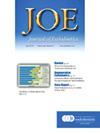Impact of Biodentine Placement on Fracture Resistance and its Influence on Discoloration with Different Scaffolds
IF 3.6
2区 医学
Q1 DENTISTRY, ORAL SURGERY & MEDICINE
引用次数: 0
Abstract
Introduction
This study aimed to investigate the fracture resistance of teeth that underwent ex vivo regenerative endodontic treatment using Biodentine placed either above or below the cemento-enamel junction (CEJ). Additionally, it examined the impact of different placement approaches, in combination with various scaffold materials (blood, platelet-rich fibrin [PRF], injectable PRF [i-PRF]), on tooth discoloration over time.
Methods
Thirty-nine human maxillary incisors were divided into three groups. The control group consisted of intact teeth. In the two experimental groups, regenerative endodontic procedures were simulated, and Biodentine was placed above or below the CEJ. Fracture resistance was evaluated after thermal and mechanical aging using a chewing simulator. In the discoloration test, 96 human maxillary incisor teeth were selected. Roots were sectioned 10 mm apical to the CEJ and canal enlargement was performed Gates-Glidden burs. Teeth were grouped according to the placement level of Biodentine (above or below CEJ) and the type of scaffold materials used (blood, PRF, i-PRF, distilled water). Discoloration was assessed by using a spectrophotometer at baseline, 1 week, 1 month, and 6 months. Data were analyzed using one-way analysis of variance followed by Tukey post hoc tests independent t-tests were used to evaluate the effect of placement location on color change.
Results
The fracture resistance of intact teeth was significantly higher than that of the group in which Biodentine was placed below the CEJ. Blood and blood-derived products resulted in greater discoloration compared to distilled water, whereas PRF induced less discoloration than blood. Furthermore, the placement of Biodentine above the CEJ led to significantly less discoloration at specific time points compared to its placement below the CEJ.
Conclusions
Positioning Biodentine above the CEJ may offer clinical advantages by potentially improving structural integrity while minimizing aesthetic concerns. When PRF is used as the scaffold material and Biodentine is placed coronally, tooth discoloration is minimized.
生物牙汀放置对断裂抗力的影响及其对不同支架变色的影响。
简介:本研究旨在研究在牙髓-牙釉质交界处(CEJ)上方或下方放置生物牙本质汀进行体外再生牙髓治疗后牙齿的抗骨折性。此外,它还检查了不同放置方法与各种支架材料(Blood, PRF, i-PRF)结合对牙齿变色的影响。方法:39例上颌切牙分为3组。13颗完整牙作为对照组,其余两组为完整牙。在两个实验组中,模拟再生牙髓治疗过程,并将生物牙牙定置于CEJ上方或下方。采用咀嚼模拟器对热老化和机械老化后的抗断裂性能进行评估。在变色试验中,选取96颗人上颌切牙。根尖距CEJ 10mm,用Gates-Glidden burs进行根管扩大。根据生物牙牙定放置水平(高于或低于CEJ)和支架材料类型(血液、PRF、i-PRF、蒸馏水)进行分组。在基线、1周、1个月和6个月时使用分光光度计评估变色情况。数据分析采用单因素方差分析,然后进行Tukey事后检验和Tukey检验;采用独立t检验评价放置位置对颜色变化的影响。结果:与放置在CEJ下方相比,将Biodentine放置在CEJ上方可提高抗骨折性,但差异无统计学意义。完整牙的抗折能力明显高于生物牙定放置在CEJ下方组。与PRF相比,血液导致明显更大的变色。与蒸馏水相比,血液和血液衍生产品导致更大的变色,而PRF比血液引起的变色更小。此外,在特定时间点,生物牙定放置在CEJ上方比放置在CEJ下方导致的变色在统计学上显著减少。结论:在再生手术中,冠状放置生物牙本质可以增强牙齿对断裂的抵抗力,而使用PRF等支架材料时,变色的可能性较小。将Biodentine放置在CEJ上方可能通过潜在地改善结构完整性同时最大限度地减少美学问题提供临床优势。当使用PRF作为支架材料并在冠状位置放置生物牙本质时,牙齿变色最小化。
本文章由计算机程序翻译,如有差异,请以英文原文为准。
求助全文
约1分钟内获得全文
求助全文
来源期刊

Journal of endodontics
医学-牙科与口腔外科
CiteScore
8.80
自引率
9.50%
发文量
224
审稿时长
42 days
期刊介绍:
The Journal of Endodontics, the official journal of the American Association of Endodontists, publishes scientific articles, case reports and comparison studies evaluating materials and methods of pulp conservation and endodontic treatment. Endodontists and general dentists can learn about new concepts in root canal treatment and the latest advances in techniques and instrumentation in the one journal that helps them keep pace with rapid changes in this field.
 求助内容:
求助内容: 应助结果提醒方式:
应助结果提醒方式:


